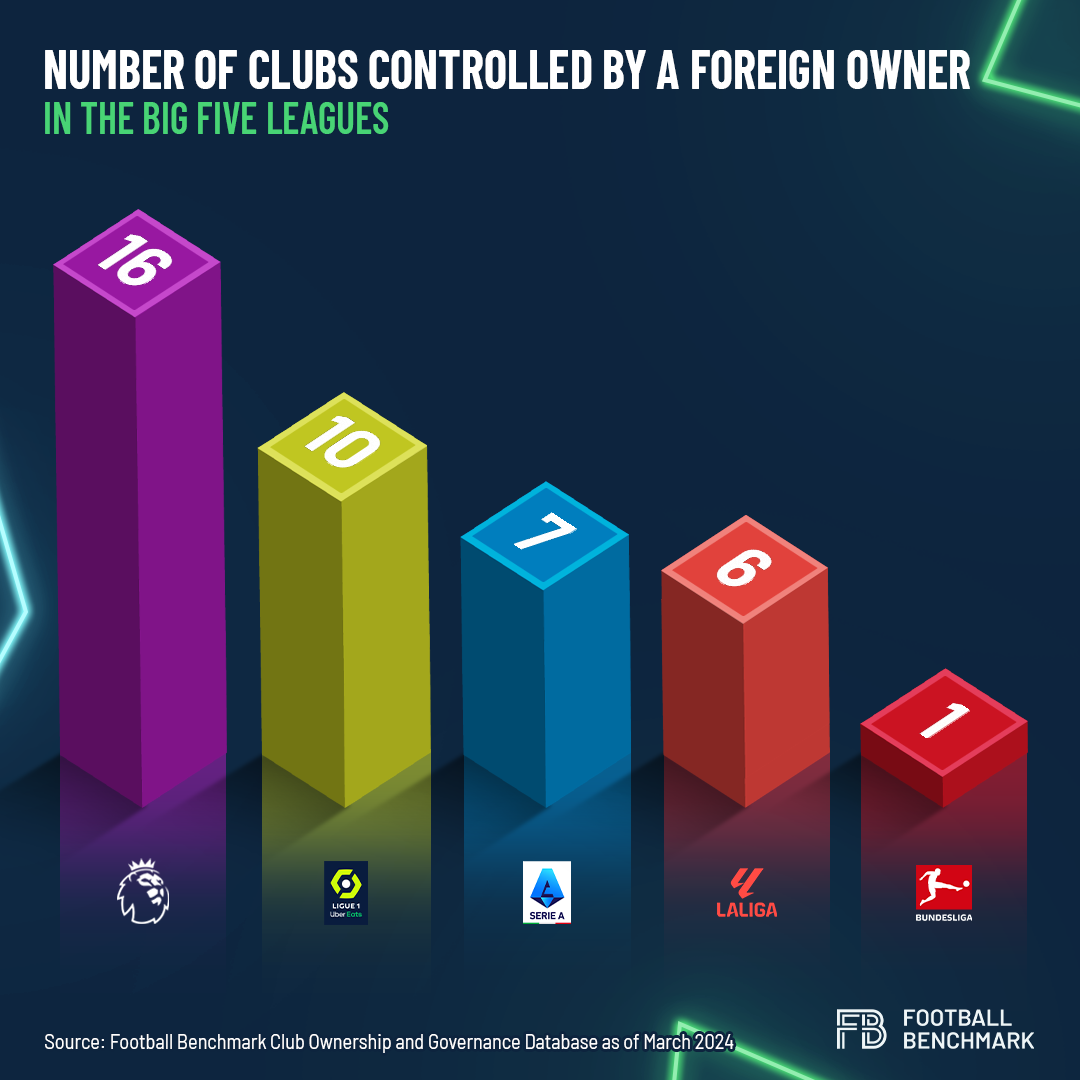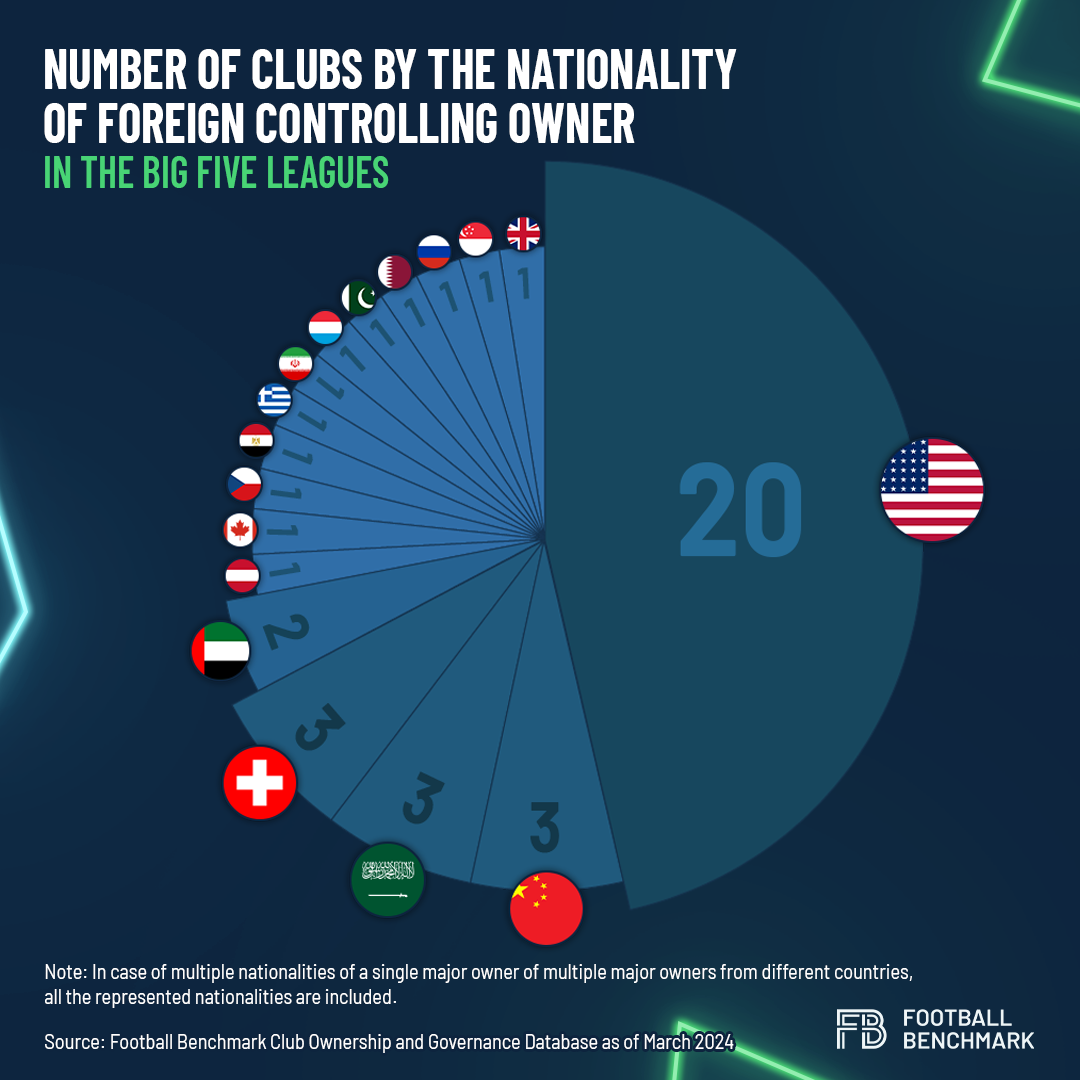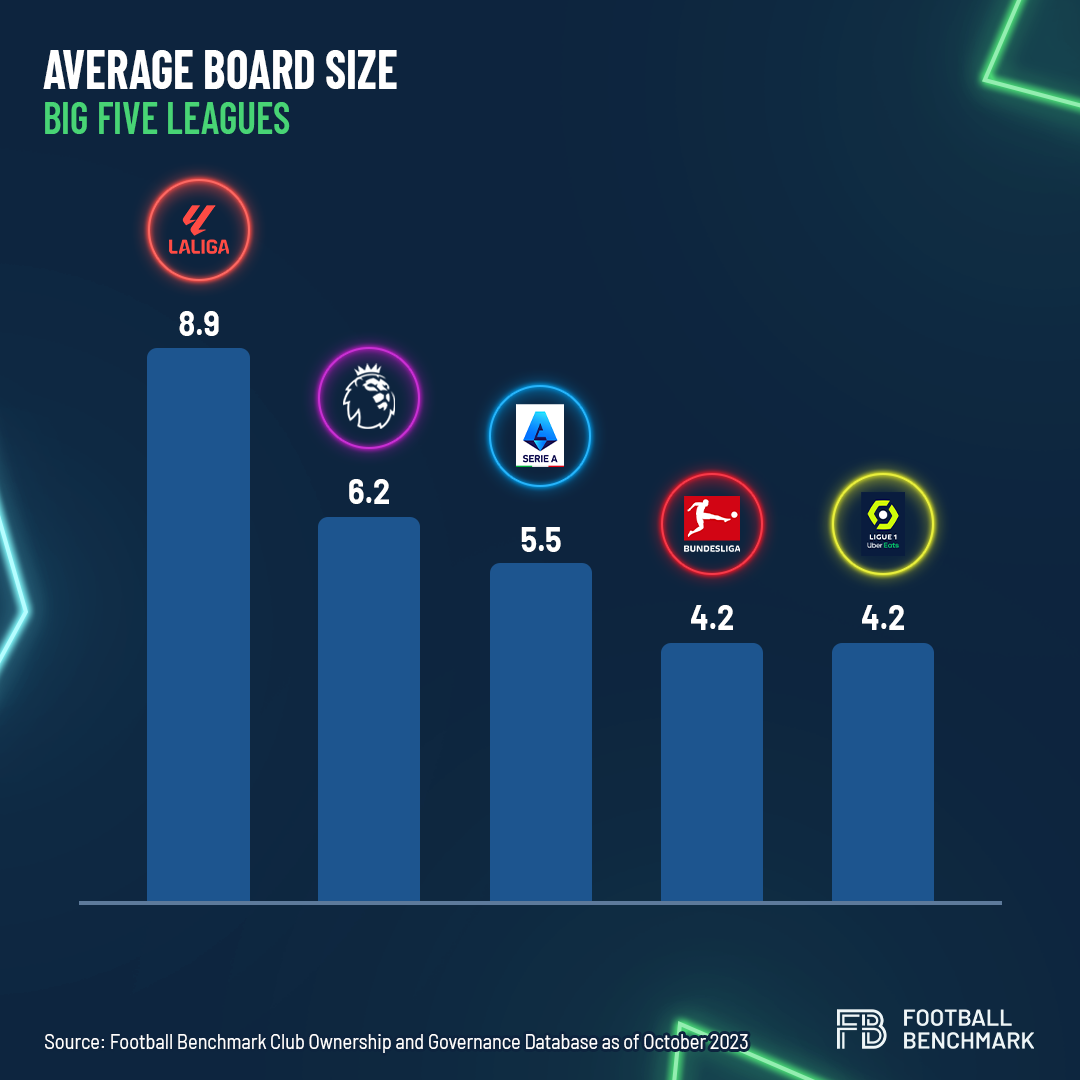In recent years, there has been a notable surge in ownership changes across Europe's "Big Five" football leagues, as highlighted in one of our previous articles. However, the enduring allure of clubs in these elite leagues is no mere coincidence; many of these clubs boast rich legacies spanning over a century, impassioned fan bases, cutting-edge youth academies, and iconic stadiums. With the globalization of the football industry, takeover opportunities became open to a wider group and foreign owners are quite common nowadays. How many operate within each league and where do the foreign owners come from? Our investigative piece delves into these questions, focusing on the foreign controlling owners, thus a person or group that controls the club.
One in the German Bundesliga, sixteen in the English Premier League
Recent years have seen significant shifts in ownership at numerous prominent European football clubs. These changes have been prompted by a variety of factors: some owners regard the clubs as prestige assets, while others seek to capitalize on the latent revenue potential of football. In today's globalized landscape, it is not uncommon for team owners to hail from abroad, extending beyond the club's home nation. However, when analyzing this trend across the “Big Five” leagues—such as the Premier League and the Bundesliga—marked disparities in ownership patterns emerge.
In the 2023/24 Bundesliga, RB Leipzig stands as the sole club controlled by a foreign ownership, with its majority owner, Red Bull GmbH, hailing from Austria. This stands in stark contrast to the Premier League landscape, where only four clubs (Tottenham Hotspur FC, Luton Town FC, Brentford FC, Brighton & Hove Albion FC) have controlling owners from the United Kingdom, while the remaining sixteen clubs have at least one foreign entity in their controlling ownership.

What accounts for the stark disparity in foreign majority ownership between English and German football?
In Germany, the 50+1 rule mandates that club members (fans) maintain ownership of over 50% of the club, striking a balance between facilitating private investments and safeguarding against the dominance of owners driven solely by personal interests. By preserving a democratic framework within clubs, the 50+1 rule empowers members to participate in key decisions, including the selection of board members, and provides mechanisms to effectively address mismanagement. By preserving football's connection to its grassroots and granting fans a meaningful say, the 50+1 rule effectively upholds the integrity of the sport.
„Using the concrete example of Bayern München, the shareholders of the men's first team (FC Bayern München AG) are the members' club (FC Bayern München e.V. - 75%), Adidas (8.3%), Allianz (8.3%) and Audi (8.3%).
Things are organised differently at Dortmund. As of June 2023, the members' club actually only controls 4.61% of Borussia Dortmund GmbH & Co. KGaA, which oversees the men's first team, reserves and Under-19s. Signal Iduna (current stadium naming rights sponsor) holds 5.98% of shares, Bernd Geske 8.24%, Evonik Industries 8.19%, PUMA SE 5.32%, Ralph Dommermuth Beteiligungen GmbH 5.03% and the remaining 62.63% is floated on the stock market. However, the management company in charge of running the football club, Borussia Dortmund Geschäftsführungs-GmbH, is 100% owned by the members' club, ensuring control of matters and thus compliance with 50+1.” (source: bundesliga.com and Borussia Dortmund official website)
On the contrary, England offers a different array of opportunities, leading to a notable presence of foreign investors and owners in the league. However, this doesn't mean that ownership of English teams isn't tightly regulated; this is precisely why the “Owners’ and Directors’ Test” exists. But what exactly this is?
“The Owners’ and Directors’ Test outlines requirements that would prohibit an individual from becoming an owner or director of a club. These include criminal convictions for a wide range of offences, a ban by a sporting or professional body, or breaches of certain key football regulations, such as match-fixing. The test is applied to prospective owners and directors, who are then subject to a review on a seasonal basis.” (source: premierleague.com)
You can read the criteria of the Test in full at Section F of the Premier League Handbook.
Big Five Leagues: 20 clubs have US majority owners
When examining the nationalities of foreign majority owners in Europe's "Big Five" football leagues, it becomes evident that United States-based proprietors hold considerable influence. With 20 controlling owners originating from the USA, it's clear that American investors have become prominent players in shaping the trajectories of these clubs. This influence can be attributed to several factors. Firstly, the immense financial power and business acumen prevalent in the United States provide investors with the resources and expertise needed to navigate the complex world of European football ownership. Additionally, the global popularity of football, coupled with the vast market potential in Europe, makes it an attractive investment opportunity for American entrepreneurs looking to expand their portfolios.
Among the clubs under the controlling ownership of individuals or entities from the United States, in the English Premier League there are ten clubs (Burnley FC, AFC Bournemouth, Chelsea FC, Liverpool FC, Manchester United FC, Fulham FC, Arsenal FC, Crystal Palace FC, Aston Villa FC and Everton FC). In Ligue 1, five clubs (RC Strasbourg, Olympique Lyonnais, Olympique de Marseille, Toulouse FC, and Le Havre FC) fall under American ownership, as do five clubs in Serie A (Genoa CFC, Atalanta BC, AS Roma, ACF Fiorentina, and AC Milan). Additionally, RCD Mallorca represents the sole club in LaLiga under the controlling ownership of an American entity.

Following the United States, China, Saudi Arabia, and Switzerland share the second position on the list, with each country boasting controlling ownership of three clubs.
Moreover, the diverse representation of 17 nations among foreign owners in the “Big Five” underscores the globalization of European football ownership. This mosaic of nationalities reflects the interconnected nature of the modern world, where capital flows freely across borders and investors seek opportunities beyond their home countries. It also highlights the growing commercialization of football, where clubs are viewed not just as sporting institutions but also as business ventures with the potential for returns on investment.
Navigating the Boardroom
The intricate dynamics of football business extend beyond the pitch to the boardrooms, where governance structures differ significantly across the prestigious "Big Five" leagues. The examination of average board sizes offers intriguing insights into the administrative frameworks characterizing each league.

An intriguing aspect of the governance structures within Europe's top football leagues lies in the varying sizes of their board memberships. LaLiga takes the lead with an average board size of 8.9 members, indicative of a broader framework for decision-making and oversight. Following closely behind, the English Premier League boasts an average of 6.2 board members per club, representing a slightly leaner administrative setup without sacrificing effectiveness. Serie A maintains a middle ground with an average board size of 5.5, while both the Bundesliga and Ligue 1 share a comparable average of 4.2, signalling a more streamlined approach to governance and decision-making processes within these leagues. These statistics shed light on the diverse governance models employed by Europe's top football leagues, each tailored to meet the unique needs and challenges of their respective environments.

.png)

